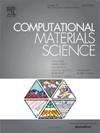Investigation on damage mechanism and optimization strategy of the LiCoO2 composite cathode in All-Solid-State Lithium Battery
IF 3.1
3区 材料科学
Q2 MATERIALS SCIENCE, MULTIDISCIPLINARY
引用次数: 0
Abstract
Solid-state composite electrodes play a crucial role in all-solid-state lithium batteries (ASSLBs). However, strain mismatch between the active material (AM) and matrix volume changes during discharge/charge cycles induce diffusion-induced stresses, resulting in the degradation of the solid composite cathode. In this study, we develop a particle-level geometric model to investigate the damage evolution in the solid electrolyte (SE) caused by ion/electron migration in the SE matrix, material transfer in the active particles, the interaction between the SE matrix and active particles, and the local current density at the SE/AM interface. We simulate the effect of mechanical damage on the electrochemical properties by coupling the damage variables and the ionic conductivity of the SE matrix. Our research results indicate that at higher discharge rates, the capacity decline caused by mechanical damage worsens. Furthermore, an increase in the volume ratio of active particles leads to additional damage in this model. Therefore, while maintaining an appropriate volume ratio, we propose a larger particle LS (larger particle near separator) dual-gradient near the separator, which will increase the discharge capacity by 8.5% at a discharge rate of 2C.

求助全文
约1分钟内获得全文
求助全文
来源期刊

Computational Materials Science
工程技术-材料科学:综合
CiteScore
6.50
自引率
6.10%
发文量
665
审稿时长
26 days
期刊介绍:
The goal of Computational Materials Science is to report on results that provide new or unique insights into, or significantly expand our understanding of, the properties of materials or phenomena associated with their design, synthesis, processing, characterization, and utilization. To be relevant to the journal, the results should be applied or applicable to specific material systems that are discussed within the submission.
 求助内容:
求助内容: 应助结果提醒方式:
应助结果提醒方式:


